Wednesday, September 18, 2024 – Volume 38 Issue 5
@tccthecollegian • collegian.tccd.edu

Wednesday, September 18, 2024 – Volume 38 Issue 5
@tccthecollegian • collegian.tccd.edu
FOUSIA ABDULLAHI editor-in-chief collegian.editor@tccd.edu
Tarrant County Commissioners voted 4-1 to add more polling stations around the county instead of removing several college campus early voting locations.
Judge Tim O’Hare was the only one who voted against keeping early polling sites open at TCC South and NE Campuses, UT Arlington and Southern Baptist Theological Seminary.
O’Hare questioned the need for college campus sites when voter turnout is lower, the sites are close to each other, and parking is inaccessible.
Both democratic commissioners, Roy Brooks and Alisa Simmons, were on a preplanned trip to Washington, D.C. They joined the court meeting via live feed and were able to vote.
Tarrant County election administrator Clint Ludwig proposed changes that considered three options.
Option one was to look at the
CHEYENNE SHAWN campus editor collegian.editor@tccd.edu
TR Campus has created a space where students can be vulnerable when expressing their art.
Roots & Reflections allows students to submit nonfiction, fiction, poetry, photographs and other art designs.
This publication is completely student-led. Students can find flyers around campus that give you the information on how to submit your work.
In the past, students took a class where they could read and view all submissions. Each submission is viewed anonymously.
The goal for each design or writing piece chosen is to see how it speaks to college students. This year was done differently. Due to the class being canceled, they had to work with a small group. It didn’t stop them from getting it done.
Samantha Goldblatt was one of the students that helped co-edit and had some of her art published. She said one of the pieces featured meant a lot to her. It’s called “Maternal Ties” and is about Judaism and her connection to it.
“I have a lot of doubt about whether I’m Jewish enough or not,” Samantha said. “It’s something that I kept going through last year, I’m glad I could write something about it.” See Lit Mag, Page 2
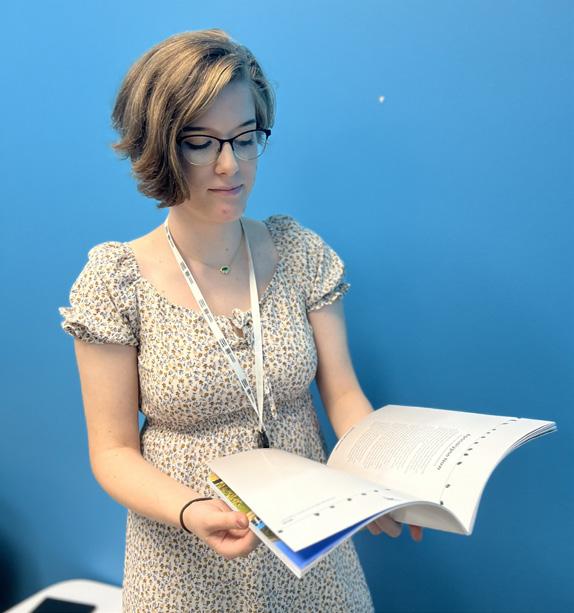
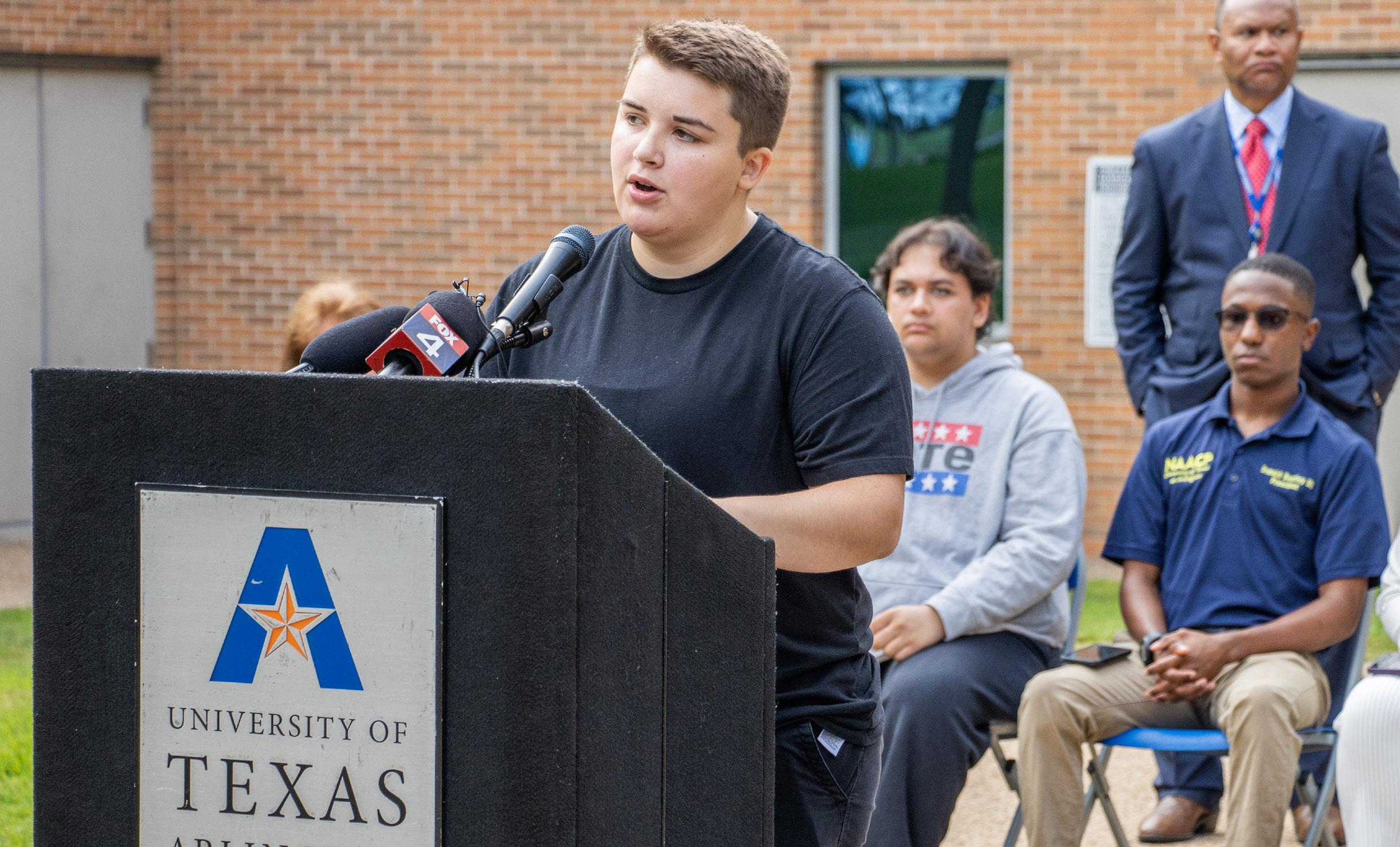
FRED NGUYEN campus editor collegian.editor@tccd.edu
TCC has partnered with New Heights Adult High School to provide a free dual-enrollment charter school for adults.
New Heights, which started its first term Sept. 3 with over 500 students, allows residents ages 18 to 50 the opportunity to earn a high school diploma and a career or technical certificate from TCC.
Ivett Penago, a student at New Heights, had to drop out of high school after getting pregnant and was looking for a night school to fit her busy life. She has worked at her job for eight years but wants to do more to advance her career.
“I have [the] knowledge to be a supervisor but because I don’t have a title, they give it to people that have a degree,” Penago said.
Traci Berry, CEO and superin-
HUDA QURESHI LAUREN HARPER collegian.editor@tccd.edu
Masika Smith was embracing a peaceful moment of quiet when she ran into the concerning thought millions of people have faced globally.
“I remember thinking, oh my goodness, I just want to stay in this silence forever, because my life had felt chaotic, she said. “I was busy. I had little kids that I was taking care of, I was working full time, and I was just feeling overwhelmed. … I just remember stopping and asking myself, Masika, what was that thought? What were you really thinking about? And guess what? I wasn't thinking about sleeping.”
Smith, a counselor on NE Campus, was diagnosed with major depression. She found this
tendent of New Heights, has been a proponent of helping adults like Penago pursue their education for the past decade.
In 2014, she set up a pilot program in Austin that focused on helping adults earn high school diplomas after realizing people lack access to it after turning 26.
“With people working longer in life, not retiring till their 70s, there’s work opportunities that people were not able to access because of [not] having this education,” Berry said.
In the spring of 2023, Senate Bill 2032 paved the way for adult high school programs in Texas. Supporting data for the bill stated that more than 7 million adults in Texas do not have a high school diploma.
New Heights is located at the TCC Opportunity Center and is supported by the South Campus.
TCC South President Daniel

Lufkin said the partnership between New Heights and TCC will be good for the community.
“It provides people an opportunity to achieve a high school diploma that they may have missed the opportunity for various reasons,” Lufkin said.

surprising considering what she did for a living.
“No matter what your profession is, no matter what your interests are, the one thing we have in common is we are human beings,” she said. “We have emotions. We have feelings. Life happens to all of us.”
September is Suicide Awareness Month. TCC students and staff participated in various ways to combat the stigma surrounding
suicidality as they attended the programs on campus.
Students reflected on what can be done to prevent suicide. Many of them concluded that community plays a huge role, including Leslie Garcia and Keland McClanahan.
Garcia said she had gone through a rough period in which she was around people who enabled her addiction.
“I would look at myself and hate myself,” Garcia said.
She said she was able to overcome the situation by surrounding herself with a good support system.
“It was like a breath of fresh air to be around them,” she said.
“I realized that those negative thoughts weren't there anymore.”
McClanahan echoed the sentiment of relying on a community through difficult times.
“It's really important to have a community on campus who's there to support you, and also, if
“And we know that with a high school diploma as well as a college degree or certificate, you’re going to earn substantially more over your lifetime and also have the opportunity to advance within a career.”
See New Heights, Page 2
need be, to prevent you from having suicidal thoughts or indulging in anything that isn't beneficial to your life or is detrimental to your safety,” he said.
TCC has a CARE team, a group of individuals from different student affairs departments who come together to offer comprehensive support to students in distress. Tayren Mangolini-Thomas, the Director of Student Conduct and Preventative Education said the CARE team often sees the issue of students experiencing suicidality around midterms.
“We have a lot of students come in [who] are like, I don't know if I could do this,” Mangolili-Thomas said. “I don't know if this is the place for me, because they saw that they failed an exam earlier, or the weight and the load of taking care of their family and trying to do school.”
See Suicide, Page 2
husband who is of Mexican descent, along with her children.
Connect Campus sponsored ¡Celebramos! A Celebration of Latin American Culture and Heritage at The Fort Worth Botanical Gardens on Sept. 14. to honor the start of Hispanic Heritage Month.
Leo Longoria, Connect Campus Spanish instructor, said that he came out to represent the Hispanic culture and all the different types of cultures at TCC. He also said that the Hispanic culture is celebrating Mexican Independence Day which takes place on Sept. 16. Mexican Independence Day honors Mexico’s independence from Spain and is not to be confused with Cinco de Mayo, which is when Mexico won a battle against the French Army and was popularized by the Hispanic and Chicano communities of the 1960s and 1970s in the United States said Longoria.
Susan Martinez, Connect Campus psychology instructor, said that she came to support the diversity of the community with her
Connect Campus government instructor, Olivia Agudelo, said that she came out to celebrate her culture with her daughter who is half Mexican and half Colombian, along with her husband.
Both Longoria and Agudelo were born in Mexico and came to the United States when they were young. They both said how important their families are, and how that helped to shape them into the people that they are today.
TR and Connect Campus student Shelsy Arevalo said that family is the first thing that she thinks of when talking about Hispanic Heritage. She enjoys spending time with family and attending the events that happen during Hispanic Heritage Month.
“You should be proud of where you come from, no matter where that is and everyone should be celebrated,” Arevalo said.
“Don’t be afraid to show your pride and culture,” she said. Hispanic Heritage Month is celebrated from Sept. 15 through Oct. 15.
Heights (continued from page 1)
Penago was introduced to New Heights through social media and “jumped on it.”
After a week of class, she was surprised how accommodating the class schedule was with her busy schedule
Students at New Heights can take as many classes at once as they choose, which can range from the early morning to late night.
This accommodates students with jobs and families who can only come in at certain times of the day.
Cipriano Vedia is another student at New Heights who found out about it through social media.
He said New Heights offers an opportunity for him to get better jobs or find a different career path.
“Life just happened for a lot of us,” Vedia said. “We had to get out of school for whatever reason we all had.”
Berry aims for New Heights to continue to grow in Tarrant County and draw in more students.
“It’s been a really energetic and positive start,” Berry said. “And we’re just excited to
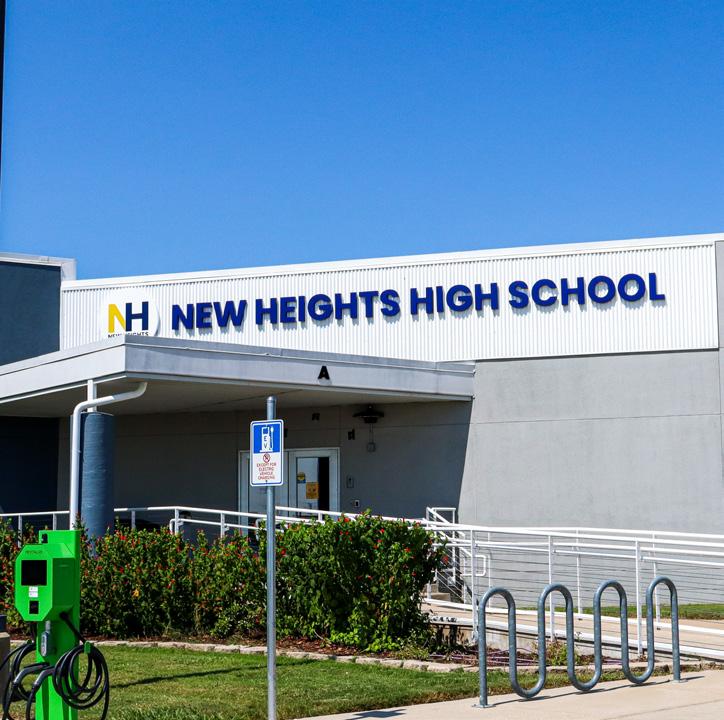
keep enrolling more students to give them the same opportunity.”
New Heights Adult High School is currently accepting applications for the second term, which will begin Oct. 15.

(continued from page 1)

Former TCC student Titus King who’s published poems in Root & Reflections spoke about his favorite poem he wrote, which was titled “Trauma”.
“I got diagnosed with cancer during the pandemic, it was my first reaction to the whole experience,” he said.
He said writing this poem was his coping mechanism when everyone was isolating themselves from each other.
“It’s a very vulnerable piece, it got me talking to external figure whether that be a person or god or whatever,” King said. “I’m pretty sure a lot of people can relate or identify to that.”
Students are advised by Professors Jerrica Jordan and Janae Corrado. Both have experience in journalism and graphic design. They use their experience to provide input to students regarding their work in the magazine.
“I want students or other readers to find something they identify with,” Jordan said. “For example, our writers are students who are pretty quiet in the classroom, but they have so many things to say.”
than five hours.
(continued from page 1)
Both supporters and opponents of the proposed site closures agreed on the importance of voting and urging the crowd to go out to vote during early voting as well as election day. that everyone should go out and vote during early elections and on the day of elections.
Supporters argued that these sites are crucial for young voters, communities of color and those with disabilities.
Former TCC instructor Janine Lund taught psychology at TCC for 18 years and used her three minutes to talk about keeping the campus voting locations.
“I voted there on the Northeast campus when early voting was available because it was convenient for me and for many students,” Lund said. “Having a familiar place to vote, especially for first-time voters, is a great value, they’re on campus, and they can go somewhere they know.”
Lund also addressed the issue of parking that was brought up by saying that if you are not part of the TCC community, then it is a challenge, but if you are, then it’s easy to find parking.
Opponents highlighted the need for more objective criteria in selecting voting sites, such as voter turnout, parking accessibility and financial cost.
Daniel Eldred, a college student, addressed the polling location changes and asked the campus polling stations to be removed.
“As a college student myself, I urge the court to approve scenario one,” Eldred said. “This is by far the most practical option when considering how we structure polling places for the upcoming election. By reducing the use of college campuses as polling places and moving them to more accessible locations, we’re solving two problems at once, accessibility and cost.”
Eldred and many others mentioned that these college campuses are inaccessible to seniors. They also stated that closing the campus polling sites does not constitute voter suppression.
Christina Das, a voting rights attorney with the NAACP, argued that reducing early voting locations would disproportionately harm black, Latinx students and first-time voters.
“All three plans systemically remove South campus, polling place that serves nearly a 40% black voting age population,”
Das said. “Following that, Southwest Baptist Theological Seminary, a polling place that serves a community that 70% Hispanic voting age population.”
Corrado said that it was hard to pick a certain story or design that stood out to her. She loved them for all different reasons.
“I am, however, excited that several Spanish-language entries were accepted into our publication this year-that has not been the case in the past,” Corrado said.
“It means a lot to me to be able to express myself for everybody and show them a more vulnerable side to me” King said.
The name “Roots & Reflections” was voted by the very first class in 2020. They thought the magazine was reflective of what the student experience was like.
“It’s about letting the students do what they feel is leading them to the best outlet or the best creative expression for them, what they want to see in the magazine.” Goldblatt said.
Roots and Reflections is published annually, and readers can view the latest and previous issues at: https://tinyurl.com/2ekpmvbz
Helen Gonzales spoke out in favor of closing the UT Arlington site because she believes it is inaccessible due to a lack of parking.
“I request that you reduce the number of college campuses used for polling in November for the simple fact that our taxpayer dollars are going to waste,” Gonzales said. “Not only do they suppress voters that are disabled and elderly, but have you gone to UTA and tried to park there?”
Gonzales and others emphasized that seniors need more polling sites with easy parking access.
Students and staff who spoke during public comment stated that the parking lots are accessible, and community members benefit from the UTA location staying open.
Others noted that UTA is home to the adaptive sports program, located next to the polling site, which makes it accessible for student-athletes with disabilities.
Laura Leeman, candidate for Tarrant County commissioner precinct 3 and a mother of a physically and developmentally disabled son who was in hospice care in 2020, spoke about the importance of keeping sites open because the community depends on those places to be open during early elections.
“Having fewer places for people to vote creates chaos and confusion for any voter,” Leeman said. “Think of the law enforcement officer, the doctor, the EMS driver, the person with disabilities. Access to voting should not be hard, and voters shouldn’t have to wait in longer than typical lines or race from one location to another.”
Leeman said it’s about more than just about the 10,000 voters having access. It’s about any one person who doesn’t get to vote.
“Voting is a civic duty, while voter suppression is unpatriotic. What affects one of us affects all of us,” Leeman said.
While Gonzales wasn’t happy that the vote to increase polling sites passed, she did express that she supports more people being able to vote, but that fiscal responsibility should be a part of the decision-making.
“You know, it is what it is, but taxpayer dollars are at stake,” Gonzales said. And really, we can’t afford to lose votes of any sort because who’s going to lead our country in the future.”
The crowded courtroom broke into cheers and applause when the vote to include all the original locations plus an additional location passed.
“I would like to thank all of the citizens, particularly the students, for their engagement in local governance,” said Simmons. “Those young people, this is what it’s about.”
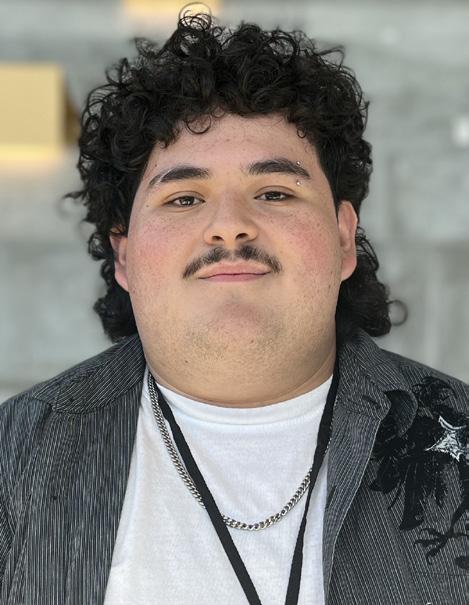
“I think reviewing the process on how to acquire guns and I think checkups on people who already own them. It’s just better to prevent it at the root instead of having to do damage control once we have a problem.”

“The age should be higher than it is now. I feel like our brains don’t develop as fast as people think they do. I think there should be more laws, more restrictions on what guns to get at what age and why you want that.”
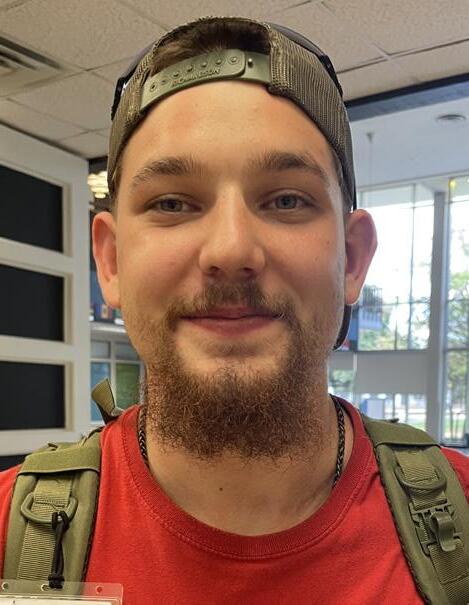
“If you give law enforcement more funding so they can get more people, they can stop that stuff a lot faster. If the feds can go ahead and do their jobs when they already have somebody on the watch list, they can start minimizing a lot of school shootings.”
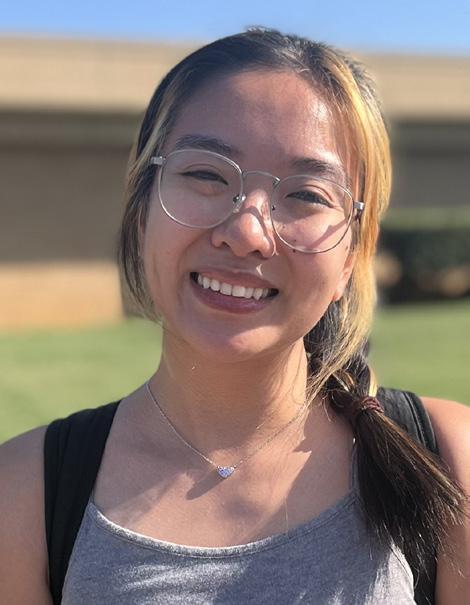
“I feel like more security before walking into any campus would be better. I know some schools have metal detectors, but I know some schools don’t have enough resources for that. Or using our IDs to scan when we walk in the buildings. I go to UTA as well, and we have that in some of the buildings. I feel like that makes it seem a bit safer.”
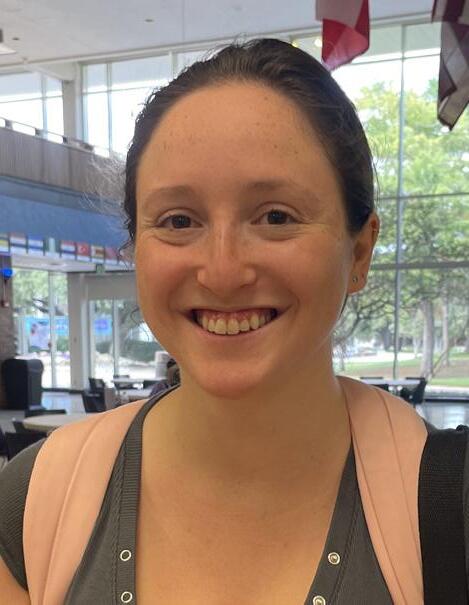
“I think it’s so sad, going to school, we don’t have shootings in the UK. To hear about it is so heartbreaking, just so sad. Just to think you’re going to school, and then that’s happening, it’s just such a cultural difference. It’s terrifying.”

“They should add more police or maybe add more cameras. I think safety should be everybody’s responsibility. If we take it as the responsibility of each person, I think that would be better than just relying on cameras or relying on police.”
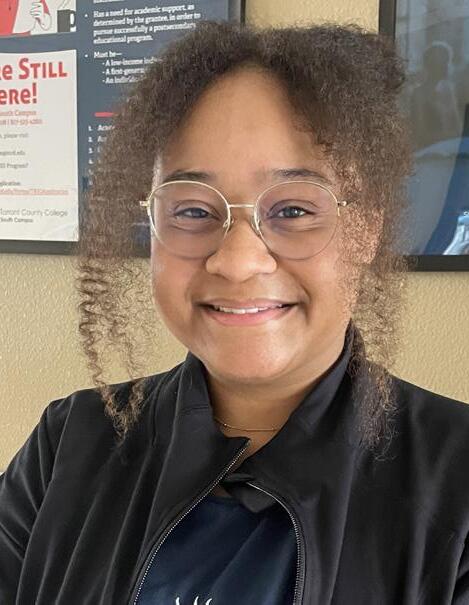
“I guess having more restrictions is, I would say, definitely always necessary, especially in the kind of generation that’s coming up and everything and how it’s being used nowadays. I think more restrictions should be put on it.”
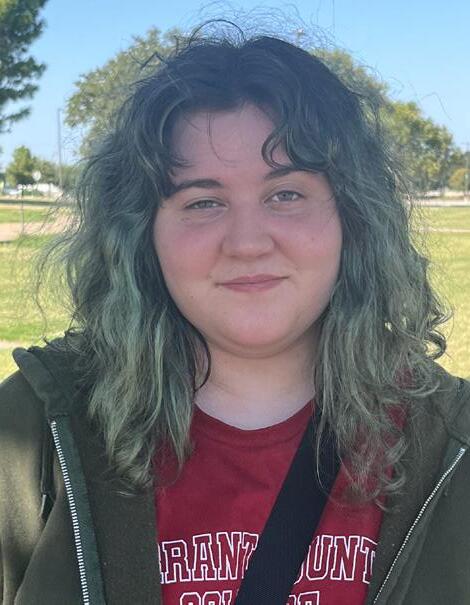
“I think that a good way to prevent [school shootings] is to listen to students when they report feeling unsafe and then immediately take action. Get someone there, make sure nothing happens.”
(continued from page 1)
Janie Ortiz is a full-time student on NE Campus. She said it’s a lot of pressure to keep up with work and other life events on top of school and it can become very draining.
“At some point, I just want to stop and take a break,” Ortiz said.
The CARE team is a place students can go to when in need of some kind of break, according to NE Counselor, Stephen Howard.
“We take the lid off, so to speak,” he said. “We reduce the pressure and increase connection and decrease loneliness, isolation and the feeling like they are the only one.”
QPR is a method used when deescalating someone who is suicidal. It stands for Question, Persuade, Refer.
The first step is to question the individual to pinpoint and understand exactly what they’re thinking.
“If you ask them, it actually brings a sense of relief,” Smith said. “Someone cares. And I can talk about this.”
The next step is to persuade. This step involves listening to the individual in crisis by giving them your full attention and the final step is to refer them to a counselor on campus.
Smith said those struggling with suicidality are looking for purpose.
“People are looking for a meaningful life, having a life that you’re happy with, you’re content or satisfied with, with suicide, most of the time is being tired of the pain,” she said.
She continued to emphasize the importance of community in overcoming suicidality.
“They need the community to help them,” she said. “It’s going to take more than just them by themselves ... It takes a support system and hopefully access to mental health care.”
If you’re in crisis, call or text the National Suicide Hotline at: 988
Cafe Music Series Featuring Simone Nicole Singer and drummer Simone Nicole will be playing at TR campus cafeteria.
Trinity River Sept. 19
Lunch and Learn: Sexual Health and Wellness
Sexual Health Awareness Month information session providing tips and resources for sexual health and well-being. 11:30 a.m. to 12:30 p.m.
24 Destination Graduation Informational event to help students with coursework and any potential barriers to graduation.
Sept. 9
A domestic violence case was reported on SE Campus, the case was closed as the victim declined to prosecute.
A criminal mischief case greater than or equal to $100 was reported on SE Campus and closed as the victim declined to prosecute.
• A sexual coercion case was reported at the Tarrant County Opportunity Center and was closed due to being an off-campus incident.
• An assault case by threat was reported on TR Campus.
• A minor was caught with an E-cigarette on NW Campus. A citation was issued, and the case was closed.
Sept. 10
• An unattended vehicle was hit on NE Campus with damage less than $200.
River Sept. 7 A disorderly conduct case was reported on TR Campus. Sept. 11
a.m. to 4 p.m.
Sept. 12
An assault case was reported by TR Campus. The case was closed and handled by another agency.
A tampering with a government record case was reported on TR Campus.
• An online impersonation case was reported on TR Campus.
A fraud case was reported on TR Campus regarding possession of identifying info less than 5 items.
To combat violence, schools have implemented absurd policies irrelevant to the issue of students’ safety.
Crocs, black clothing, hoodies and phones are now prohibited in schools across the U.S. One district in Alabama even chose to remove mirrors from girls bathrooms in middle schools.
School boards have stated the new regulations are enforced to prevent bullying, violence and distractions. However, these problems are inferior to the main concern for students, mass shootings.
Students are paranoid. Parents are fearfully obligated by the desire for their children to succeed in an environment where their lives are endangered.
Children’s education now includes monthly drills to prepare for active threats, where their realistic fears are practiced for safety training.
These drills can be initiated at any time of day without warning. Students are herded into classrooms and told to sit in a corner as a teacher locks them in and turns off the lights. Administrators then walk through the building to ensure the procedure was followed appropriately.
Although it does not matter how much training students and teachers experience, none of it prepares them for the reality of a mass shooting.
Teachers are burdened with the responsibility of a security guard, having to look out for the signs of potential danger while providing students with a safe environment conducive for learning. But as counseling services are cut from schools, teachers are left without resources for students who need help.
Mental health funding is not tied to students’ safety i. As boards of education increase their need for

The Collegian is a weekly student publication serving the Tarrant County College District. Editorial statements and advertisements do not necessarily reflect the opinion of the TCC administration.
EDITOR-IN-CHIEF
Fousia Abdullahi
MANAGING EDITOR
Huda Qureshi
ILLUSTRATOR
TJ Favela
DESIGNERS
Jerry Swinney
Elliot McWilliams
PHOTOGRAPHERS
Joan Pham
Kailey Raley
ADVERTISING COORDINATOR
Dominick Martinez
MULTIMEDIA EDITOR
Lauren Harper
DIGITAL EDITOR
Alex Hoben
CAMPUS EDITORS
Rebecca Champlin
Fred Nguyen
Ash Petrie
Cheyenne Shawn
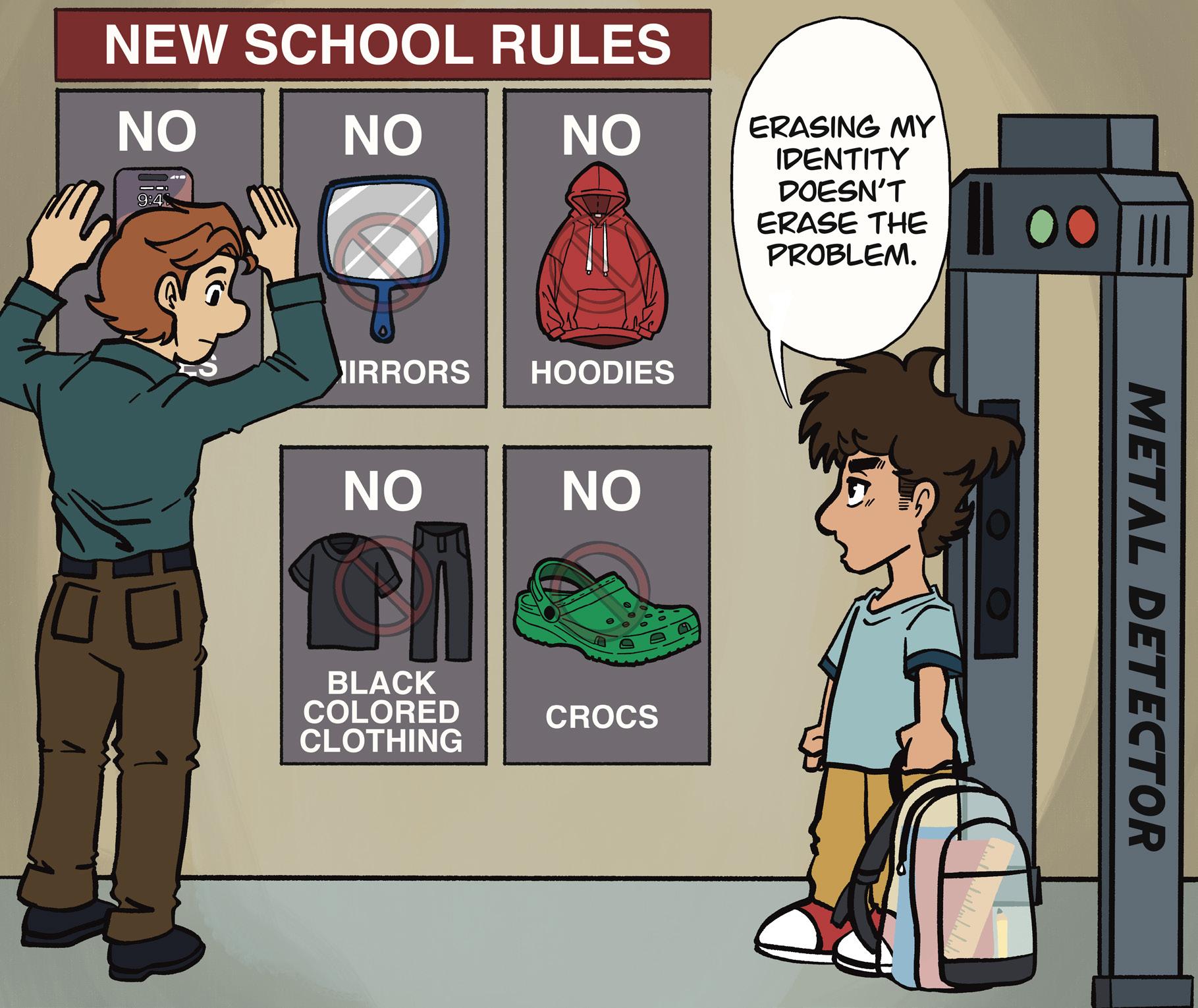
safety precautions, the spending for mental health resources and on campus counseling decreases.
School is where children grow and become young adults. This development can be difficult and isolating at times. Students admit that school can become a dreadful place where depression and anxiety thrive. Without resources on campus for the ones in need of counseling, many are left to cope with their issues alone.
The absence of care for students causes a breeding ground for troubled teens.
The U.S. Government Accountability Office reported al -
most half of all school shootings are acted out by a student from the school. Survivors of these massacres report the student displayed behavioral concerns and mental illnesses. Some confessed the student admitted prior to the shooting they had a plan intact.
An estimated 4.6 million children live in a home where at least one gun is kept loaded and unlocked, according to the Journal of Urban Health.
Trusting a child with a weapon nearby is criminal negligence.
Gifting a distressed child a loaded gun is involuntary manslaughter.
In April, Michigan parents James and Jennifer Crumbley were sentenced to 14 years in prison for the murders committed by their child. Recorded attempts by teachers to inform the parents of the concerns for their child’s mental health were ignored.
After a year of failed attempts to get Ethan Crumbley help, his parents carelessly gifted him a 9mm pistol. Three days after Ethan was taught how to shoot and reload his new toy, he murdered four of his classmates.
Ethan Crumbley’s parents avoided the noticeable signs of his instability and facilitated the deaths
of four children. Their case set precedent to the evaded issue of gun violence in the U.S.
The massacre in Georgia on Sept. 4 was the 45th school shooting this year.
Colt Gray showed signs and had been investigated a year prior by the FBI due to aggressive behavior online. His father, Colin Gray, was questioned by police in regard to the investigation.
Colin acknowledged Colt was being bullied by classmates and having difficulties managing the divorce he and his wife were in. But he refused to take ownership in the responsibility of caring for his son and failed to remove the ease of access to loaded automatic rifles.
Colin was made aware of his sons’ potential threat to the safety of other children when he gifted Colt the automatic rifle used in the school shooting. Colt’s crimes were premeditated and enabled by his father.
Both Colin and Colt sit in prison with felony charges for the massacre which could have been avoided if necessary precautions had been taken by the father. Children die daily due to the lack of gun safety and regulations must be enacted to save their lives. Countless shootings are carried out by individuals with documented mental instabilities, either by the negligence of others or ease of acquiring the weapon.
New policies in schools banning clothing, phones and mirrors do nothing to prevent the murder of children. Metal detectors, ID cards and routine checks do not solve the mental health crisis.
Students need to be cared for, listened to and protected from gun violence. Removing mirrors from bathrooms does not prevent school shootings but common-sense gun reform will.
When I was 21, I was involuntarily committed, in handcuffs, to the most hostile floor of a hospital. The floor you’re taken to when no one knows what else to do with you.
I was in the depths of a psychotic episode. Psychiatrists tried to limit my experience to tidy appointment notes and a neat diagnostic box, without care to understand the complexities and nuances that put me, and people like me, in crisis.
I told them with clarity and conviction that the medications they were forcing me to take were actively harming me, but they wouldn’t listen. I felt helpless as they reduced the most traumatic experience of my life to a diagnosis and a pill.

HUDA QURESHI managing editor collegian.editor@tccd.edu
The gap in the perception of reality between us was a chasm that couldn’t be bridged. This is because the enormity of a psychotic episode calls for extensive care the system isn’t built for, and many psychiatrists add to the problem by being condescending, dismissive and even hostile toward their patients.
The patterns of poor mental health care deteriorate even further when looking at psychiatric treatment in prison systems. If there is hope for reform of psychiatric facilities, it must go hand in hand with prison reform.
Instead of emphasizing the separation of society –unstable or well-adjusted– the idea should be to rehabilitate “sick” individuals back into the community with a system that is restorative and patient.
The current systems are harsh. They create a loop of continuous
hostile solutions, such as involuntary hospitalizations and incarceration, due to repetitive issues that were left untreated and even worsened.
A reimagining of how we care for mentally ill individuals would require critical thinking about why psychiatry disproportionately harms people instead of healing them.
I was forced to confront the impact of the flawed system when I became a victim of it. I was left deeply traumatized, and those responsible for it didn’t seem to care.
I’m willing to listen to how much psychiatry has benefited society if you’ve also been given emergency intramuscular injections against your will.
I won’t get into all the gory details of my psychotic episode, but whatever you’re imagining it to be, it was 10 times worse. A lot of that can be attributed to being locked up forcefully, with no regard for privacy or autonomy.
When I was taken away, it was so I could get the help I needed.
That help included prohibiting my parents from visiting me, making me sign legal documents without explanation and forcing me to be medicated in ways I didn’t consent to.
I wasn’t treated the way I should’ve been in my state. Everyone there deserved better.
If I could rewrite how my situation played out, I would subtract aggressive cops, constant surveillance and non-consensual medication.I would add patient autonomy, a restful environment and actual attempts to understand what individuals were going through. The people locked in the hospital with me were the only threads holding me together. I want to work toward creating a world where their experience is healing instead of painful.
We need to take a hard look at the systems that continuously harm us and prioritize their reform through the elimination of force, separation and oppression.
Vulnerability functions as a healthy coping mechanism and a harmful oversharing method. Transparency allows someone to acknowledge and process their traumas before finding a solution. Sharing struggles with a trusted confidant reminds us that one’s obstacles are not theirs to bear alone.
For many, online communities have filled that role, providing a safe space to share problems, a space unavailable in other areas of their life. There’s comfort in discovering those with similar battles and the potential for bringing awareness and understanding to the outside.
With the positives of worldwide connectivity comes the repercussions of losing control of where our information lands. When we share intimate details with the public, we can no longer dictate how and where those stories are used.
Social media’s connection to wealth and fame brought an influx of theatrical, personal posts. Creators recounted medical concerns,
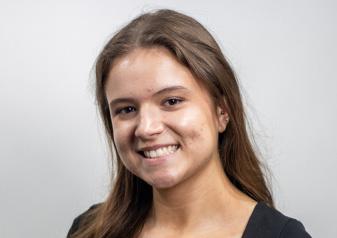
LAUREN HARPER multimedia editor collegian.editor@tccd.edu
romantic endeavors and family turmoil in exchange for views.
But unlike those looking for a community to confide in, these users found hostile responses and direct violations of their and their loved one’s privacy.
Posts detailing marital problems brought merciless comments shaming the creator and their “irreparable” partnership. Discussions of gruesome medical concerns prompted ridicule from strangers.
Secondary individuals mentioned in the posts were verbally persecuted, threatened and doxed. Their safety was compromised at
the expense of attracting clicks and internet fame.
As humans inundated with data leaks and identity highjacking, we’re responsible for protecting our privacy and the privacy of others within our control. We inherit the power to safeguard or share our thoughts, opinions and internal conflicts. However, one’s decision to publicize their struggles doesn’t excuse malicious responses. Expressing our truths to overcome our trials should not be avoided for fear of harassment or loss of confidentiality.
While cynical, not everyone considers our best interests. Who we confide in plays as much of a role in our healing as whether we confide at all.
When searching for solace, we instinctually turn to what’s familiar, often sacrificing our well-being for comfort. This pattern is reflected in other coping strategies, such as nutrition, exercise and sleep.
When we recognize the weight we bear needs another shoulder, we
reach for those closest to us, not for what will fulfill us.
Determining who will serve as an outlet for one’s stresses may not be a question of intention but of the confidant’s mental health stability and whether they can accept the mental and emotional hardships of another. Commonly referred to as trauma dumping, when we aimlessly unload our worries on those ill-equipped to handle it, we leave them feeling drained and ourselves feeling unaccomplished and burdensome.
Here, the importance of therapy and counseling is introduced, regardless of a formal diagnosis. As a resource prepared with techniques and personnel trained to help others process difficult emotions, therapy embodies the safe environment many look for digitally.
Quality over quantity encompasses how one should navigate vulnerability. As a necessary fork in the road to restoration, it should be traveled cautiously and strategically.

Scott A Garfitt/Invision/AP
Winona Ryder arrives at the premiere of “Beetlejuice Beetlejuice” in London.
MOVIE REVIEW
REBECCA CHAMPLIN campus editor rebecca.champlin@my.tccd.edu
“Let’s turn on the juice and see what shakes loose.”
The long-awaited sequel to Tim Burton’s “Beetlejuice” has finally been released and has fans of the original running to the theaters faster than Mr. Geause can say “go ahead, make my millennium.”
It is fun to see Lydia, played by Winona Ryder, as a grown, working adult with responsibilities. She has found her adult self as a paranormal television host, still encountering interactions with the dead. Her iconic, goth hairstyle still prevails, and helps viewers to remember Lydia is still Lydia, and has been through a lot in her lifetime.
Jenna Ortega shines as Lydia’s sarcastic daughter Astrid, who finds herself attracted to a boy. But in true Burton style, not everything is what it seems, and her infatuation leads to disastrous results, hurling Lydia back into the underworld to rescue her daughter with the help of Beetlejuice himself.
Catherine O’Hare plays her glorious and nutty self with the fun ease that only she can do as Delia Deetz, Lydia’s stepmother. Delia is now a famous artist and has found success as her life has evolved. The audience will find themselves laughing out loud at her digitalized artwork and the lengths she will go through in order to achieve her masterpieces.
Michael Keaton may be the ghost with the most, but he did not receive very much screen time compared to the original. Audience’s will find themselves crying out “Beetlejuice, Beetlejuice, Beetlejuice” to summon him back to the screen.
In addition, the movie missed the opportunity for Beetljuice’s famous one liner’s. Keaton did the best he could with his character
despite the lack of screen time and what made Mr. Geause so funny in the first place. Ultimately, the movie was missing key characters of the original, Barbara and Adam Maitland, played by Geena Davis and Alec Baldwin. The movie severely lacked their presence and gave very little explanation as to why they did not make an appearance in the sequel. Both Davis and Baldwin are still alive, so it is confusing as to why they were not asked back to be a part of the sequel. Also, notably absent is the character Charles Deetz, originally played by Jeffrey Jones. It is understandable why Jones was not personally in the film given that he is a convicted sex offender for child pornography. However, Burton found a creative way to bring some of the characters spark back in the underworld as a dead, shark attack victim.
The introduction of several newer characters played by Justin Theroux, Willem Dafoe and Monica Bellucci, did not do much to enhance the overall narrative of the story. They felt like big name Hollywood stars added to make up for the absence of Davis, Baldwin and Jones.
Viewers will find themselves delighted with many Easter eggs from the original such as The Handbook for the Recently Deceased, the sandworms, and a rendition of Day-O (The Banana Song) performed by young children’s choir. The late 80s nostalgia oozes from the film and will bring a smile to the faces of fans of the cult classic.
Beetlejuice, Beetlejuice is a fun trip down memory lane. It missed some key elements of the original but was an overall delight of a film, however viewers may want to skip this at the box office and opt for watching it once it becomes available for streaming.
CHEYENNE SHAWN campus editor cheyenne.shawn@my.tccd.edu
Emily in Paris brings stunning fashion choices, drama and more to Season 4.
I find this show charming. Lighthearted, short and simple. It’s the perfect show to have on in the background. There’s just enough drama to leave you interested.
This show is about a girl, Emily, who is from Chicago and works at a marketing firm that just acquired a company in Paris. Her boss was originally supposed to go but ended up being pregnant, so Emily gets go. Each new season feels like a repeat of the last, but still it feels different. The plot stays the same with how every single character is in some sort of love triangle but it it keeps getting reinvented. If it’s not Emily’s love life, it’s her friends Mindy’s.
Season 4 follows along with this. Part one begins with the aftermath of season three’s finale. What is going to happen after Camila called off the wedding to Gabriel and found out some surprising news about herself. Who will Emily pick between Gabriel and Alfie?
Part one and two packed a lot of drama into 5 episodes. I can’t say I’m a fan of the way Netflix does this.
We watch as the first episode shows us that Emily is still dealing with the news of Camille’s pregnancy. Alfie hasn’t spoken to her since he walked out after telling her he felt she was still in love with Gabriel. Agence Grateau’s client, Ami, picked Emily and Alfie for their campaign. The boss still expects the two to showcase their love as part of the mar-

The cast of “Emily in Paris” poses before the premiere in Rome.
keting strategy.
The season continues with Julien departing Agence Grateau to work with Nicolas at JVMA. His workload ends up getting dumped on Emily and Lucy. We learn more about Sylvie’s background when we find out about what happened with Louis de Leon when she worked for his company.
Part one seems more focused on the
other characters and not so much on Emily.
We see more of Mindy and her band. They get into Eurovision but need to come up with the money to go. Throughout Part 1, Sylvie is contacted multiple times by reporters seeking an interview about her former boss, JMVA Louis de Leon. They want to know more about his controversial relationships with women in the
workplace. At first, she doesn’t want to, but eventually she does.
Part 2 returns with more drama as Emily finds herself in Rome.
I found this half to have more going on for it. We get introduced to another love interest for Emily, who happens to be Italian. For a fictional character she sure is a lucky girl. She’s lucky in love when it comes to foreign boys.
Emily and Gabriel end up breaking up and take space from each other. Sylvie’s step daughter, Genevieve, shows up and starts working for her. She’s also American. Julien comes back to work for Agence Grateau. Gabriel might end up with a Michelin star after all.
Emily’s flight to Chicago gets cancelled so she ends up spending Christmas with Gabriel, Camille and her family. While on this trip, she meets Marcello. She wasn’t expecting to run into him again.
Later in the season, Marcello returns and brings a new romance to Emily. She ends up showing him around Paris. He ends up doing the same for her in Rome.
Season four ends with Agence Grateau launching a Rome office, which Emily is picked to lead, giving her a reason to stay in Italy near Marcello. Mindy is heading to be a judge on Chinese popster. Gabriel finds his way to Rome after finding out that’s where Emily is.
I enjoyed this season overall. It was once again a fun, lighthearted show to watch in the background.
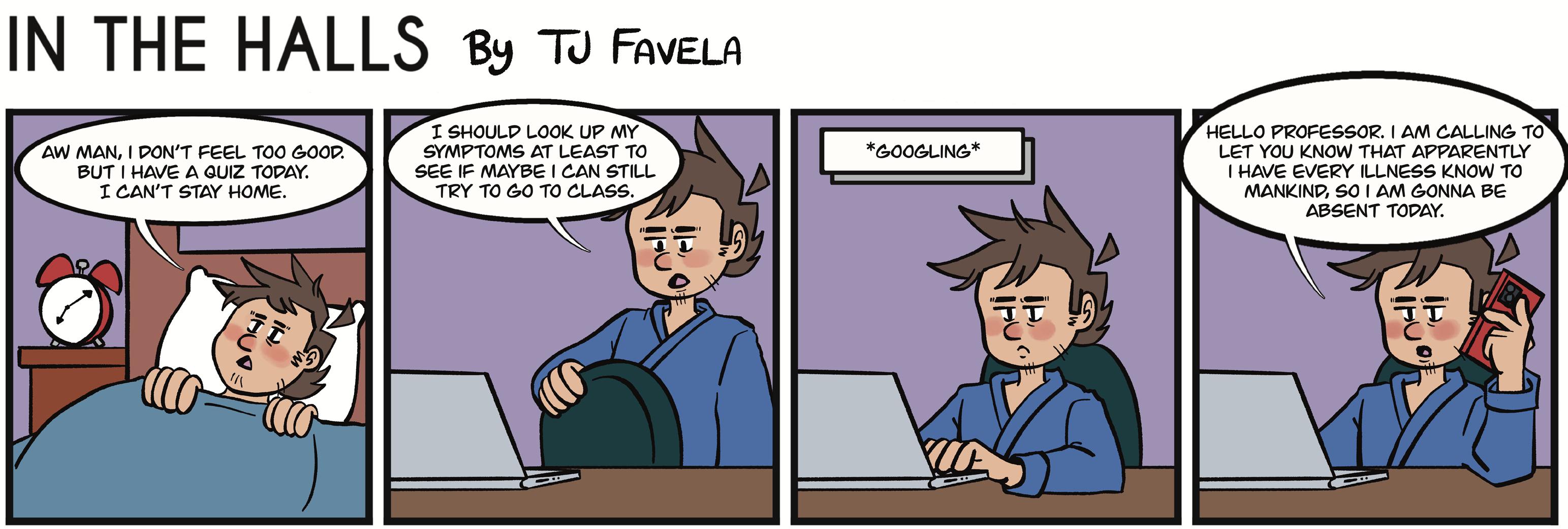








software.”
AI is becoming more widespread and colleges are finding ways to use it ethically in coursework.
People use different types of AI daily and may not even realize it. Enhanced learning is used in everything from purchase suggestions to location maps such as Siri, Alexa, search engines and even Uber ride prices and routes.
TCC’s AI Taskforce has named the initial winners of the AI Innovation Award, which recognizes exceptional, ethical and inventive use of artificial intelligence (AI).
This award is intended to promote the integration of AI across different areas, support innovative applications that improve student outcomes, increase program efficiency and advance thought leadership.
The winners are Katsuhiko Oda, associate professor of Geographic Information Systems (GIS), Cindy Allen, assistant professor of English and Kaylin Ortiz, assistant director of Educational Partnerships.
Oda explained the integration of AI-enhanced tools in their GIS program to teach the latest geospatial technologies.
“So nowadays, GIS software introduces more AI-enhanced tools,” Oda said. “Especially the deep learning modules for interpreting the satellite imagery and the area photographs for the more efficient and accurate GIS, task specialist, image interpretation.”
In his 2024 vast-based analysis class focused on learning skill concepts for learning image interpretation since GIS professionals have begun using AI-enhanced deep learning tools, he also incorporated it into his class lesson.
“Students learned the concept of geospatial, geo AI,” Oda said. “It’s the deep learning modules incorporated into GIS. Then they launched the techniques for detecting the specific type of objects on the earth.” Students learned techniques for detecting specific types of objects on the Earth. They performed the analysis for detecting wind turbines using the deep learning Python module.
One student also tried detecting vehicles in the parking lot using satellite imagery and deep learning-enhanced tools. The students learned how to use the pre-trained model and during the course, how to retrain it.
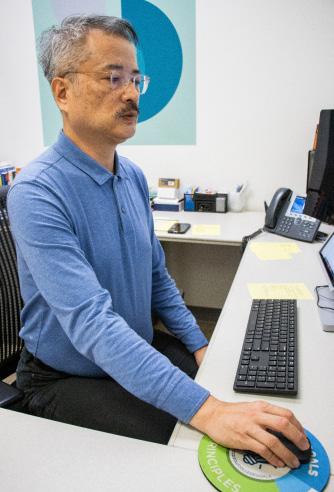
“I learned how to train the model by myself, but I hope I’ll incorporate that topic and skills into my master-based analysis course,” he said. “Then I’ll share my teaching material with other adjuncts.” Brendan Nunez, a GIS program student,
is in his final semester and took Oda’s class in the past.
“It focuses on the core concepts and mapping or GIS software,” Nunez said. “Particularly with Esri’s software. They’re kind of the powerhouse of the industry in regard to
Nunez explained how he used AI-enhanced learning in class, mainly on images and mapping objects.
The main difference is that with standard AI tools like Chat GPT, you ask it to do something already known, whereas with GIS, you train it.
“Once it’s taught it has a learning process, and it begins to understand what you’re asking of it,” Nunez said.
Staff member Kaylin Ortiz won an award for her presentation on AI to her coworkers. She said this showed how easy and important it is to incorporate AI in the workplace.
“In my job, you know, I do a lot of emails. I’m creating timelines for things, creating event schedules,” Ortiz said. “And so, AI really helps me to do the things like, obviously, I can do, but it can do them quicker.”
Ortiz said AI is here to stay, and we must learn how to use it. She wanted to get people interested and to start using it.
In his book “Co-Intelligence: Living and Working with AI”, Ethan Mollick, a professor of management at Wharton, said we need to start working together with AI.
“In field after field, we are finding that a human working with an AI co-intelligence outperforms all but the best humans working without an AI,” he said. Ortiz and other TCC employees were part of a book club that spent a month reading and meeting to discuss Mollicks book.

